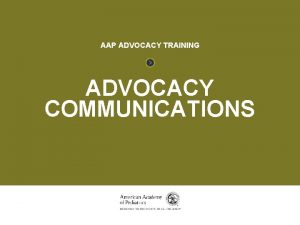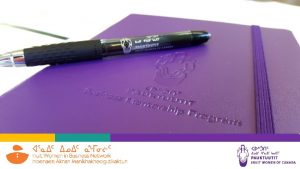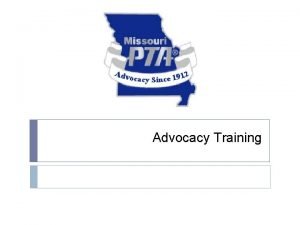Arts Advocacy Presentation Checklist for the Arts Advocacy











- Slides: 11

Arts Advocacy Presentation • • • • • • Checklist for the Arts Advocacy Presentation and Reflection ____Talk with your mentor teacher about a selecting an audience and a focus for your talk ____Schedule a time and date for your arts advocacy presentation ____Select a focus for your presentation ____Develop a strategy for engaging the audience briefly ____Create the presentation (10 – 15 slides) ___Title Page (including name and date of the presentation) ___Audience is indicated and the focus of the presentation is clear ___Brief experience is included to engage the audience ___Background information or research in art education is provided ___Audio and/or visuals are included in the presentation. ___Open-ended questions (many possible answers are correct) or references to high-level critical thinking are part of the presentation. ___Relevance to literacy skills and elementary curriculum is included. ___Reference list is provided. ___Engaged in the writing process to revise your presentation and your talk ___Shared with a peer to practice presenting and includes name of peer below ___Proofread your presentation again ___Post your presentation in Forums and Assignments for peer and instructor review ____Practice setting up the digital projector you will use in the location of your presentation ____Reflect on the practicing your presentation and the response of your audience ____Post your reflection in Assignments for Instructor Review ____Name of Peer you practiced with _______________

Art means work, language, and value For Teachers, Principals, and Tutors The National Art Education Association states that “Art education stimulates language-spoken and written-about visual images……encourages linguistic skills.

Arts: Guiding Questions • Share some of your art experiences in Elementary School • What was your favorite act project? Why • What was your least favorite act project? Why • List some of the your feelings you feel while drawing, painting, dancing, or playing music? • What are some ways the arts helped you?

Study: Arts education has academic effect By Tamara Henry, USA TODAY WASHINGTON — Schoolchildren exposed to drama, music and dance may do a better job at mastering reading, writing and math than those who focus solely on academics, says a report by the Arts Education Partnership. "Notions that the arts are frivolous add-ons to a serious curriculum couldn't be further from the truth, " says James Catterall, education professor at the University of California-Los Angeles, who coordinated the research. The report is based on an analysis of 62 studies of various categories of art — ranging from dance, drama, music and visual arts — by nearly 100 researchers. It's the first to combine all the arts and make comparisons with academic achievement, performance on standardized tests, improvements in social skills and student motivation. Catterall says the studies suggest that arts education may be especially helpful to poor students and those in need of remedial instruction. "While education in the arts is no magic bullet for what ails many schools, the arts warrant a place in the curriculum because of their intimate ties to most everything we want for our children and schools, " Catterall says. The report took two years to produce, with funding from the National Endowment for the Arts and the U. S. Department of Education. Gerald Sroufe of the American Educational Research Association describes the report as "a benchmark" and "a starting place for future research in the arts because it represents a fairly comprehensive picture of what research-based knowledge exists. " However, he says, the report is "necessarily a thin volume, including some rather thin studies. " Eileen Mason of the National Endowment for the Arts says that President Bush has requested $11 million to support arts education projects. "We are eager for more research, " Mason says. "We want to learn more about how we can best convey to our children the knowledge and skills required to create, perform and respond to the arts. At the same time, we need to know more about how the arts help to develop other capacities of our children, such as language, reading and spatial reasoning. " School officials often complain that arts programs tend to be the first cut in schools facing budget deficits. G. Thomas Houlihan, executive director of the Council of Chief State School Officers, acknowledges that many school superintendents, principals and teachers are unaware of the value of arts education. He says copies of the report will be distributed to school leaders throughout the nation. Houlihan says he was impressed by the one study finding that "arts motivate and reach certain students. " The Arts Education Partnership is a coalition of more than 100 national education, arts, philanthropic and government organizations. CCSSO and the National Assembly of State Arts Agencies administer the partnership under a cooperative agreement with the Education Department and the National Endowment for the Arts. 05/2002

Continuation of; Study: Arts education has academic effect Expanding the Mind The Arts Education Partnership, arguing for the importance of arts in schools, says various art forms benefit students in different ways: • • • Drama Music Dance Visual arts Multi-arts (combination of art forms

Drama • Helps with understanding social relationships, complex issues and emotions; improves concentrated thought and story comprehension.

Music • Improves math achievement and proficiency, reading and cognitive development; boosts SAT verbal scores and skills for secondlanguage learners

Dance • Helps with creative thinking, originality, elaboration and flexibility; improves expressive skills, social tolerance, selfconfidence and persistence.

Visual • Improve content and organization of writing; promote sophisticated reading skills and interpretation of text, reasoning about scientific images and reading readiness.

Multi-arts (combination of art forms). • Helps with reading, verbal and math skills; improves the ability to collaborate and higher-order thinking skills.

Resources • National Art Education Association, Why Art Education? , August 2014. http: //www. arteducators. org/advocacy/whyart-education • Photos from bing “Arts”. http: //www. bing. com/images/search? q=arts&qs=n&form= QBIR&pq=arts&sc=8 -4&sp=-1&sk=
 Creative arts grade 8 assessment
Creative arts grade 8 assessment Kontinuitetshantering
Kontinuitetshantering Novell typiska drag
Novell typiska drag Nationell inriktning för artificiell intelligens
Nationell inriktning för artificiell intelligens Ekologiskt fotavtryck
Ekologiskt fotavtryck Varför kallas perioden 1918-1939 för mellankrigstiden
Varför kallas perioden 1918-1939 för mellankrigstiden En lathund för arbete med kontinuitetshantering
En lathund för arbete med kontinuitetshantering Särskild löneskatt för pensionskostnader
Särskild löneskatt för pensionskostnader Tidbok yrkesförare
Tidbok yrkesförare Anatomi organ reproduksi
Anatomi organ reproduksi Förklara densitet för barn
Förklara densitet för barn Datorkunskap för nybörjare
Datorkunskap för nybörjare





















